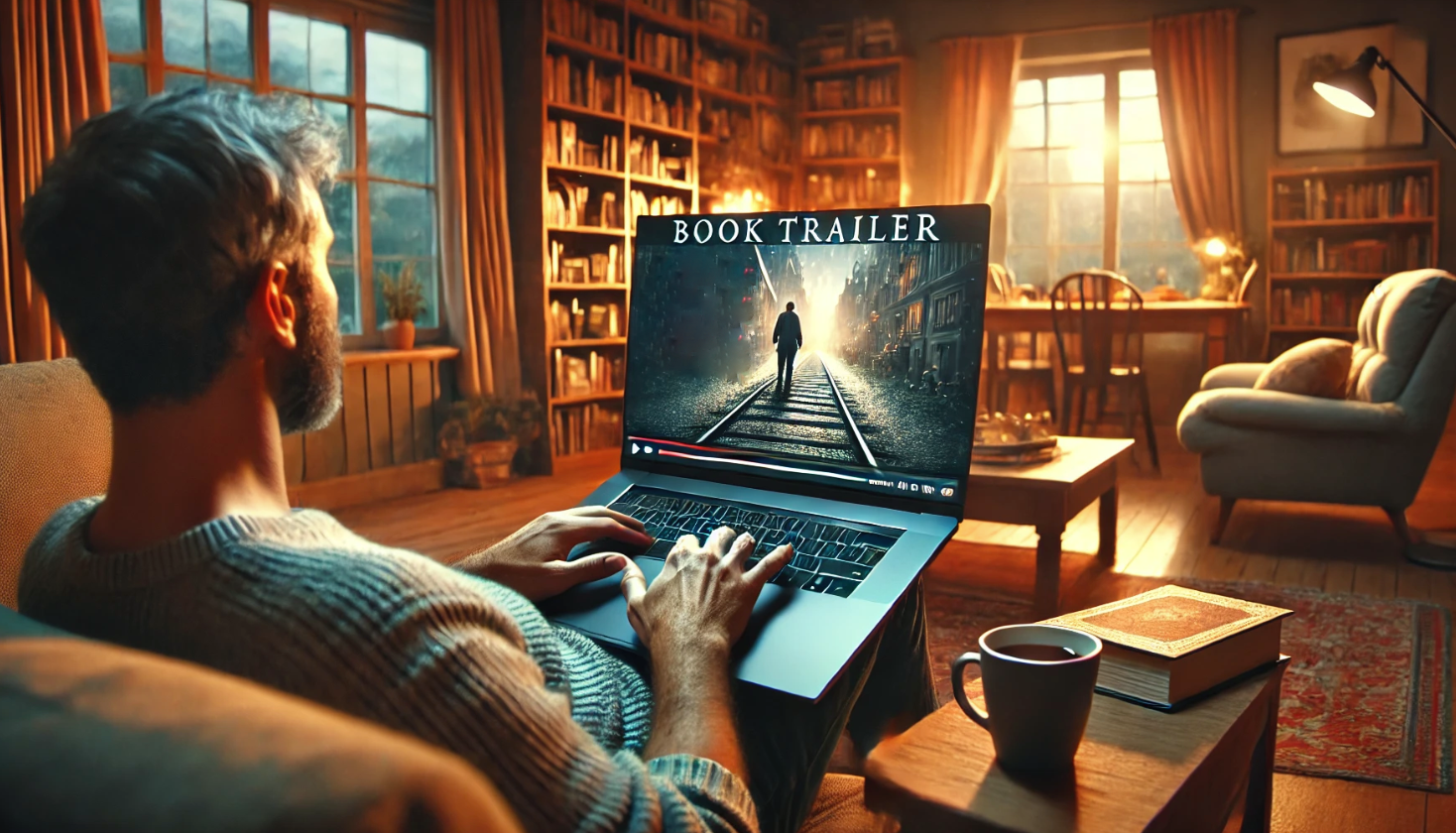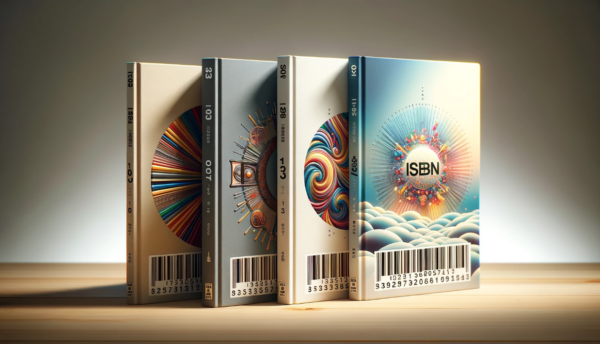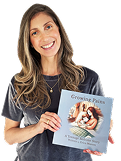Imagine this: Your book transformed into a visual masterpiece, complete with dramatic music, captivating visuals, and an irresistible narrative hook. Sounds like a movie trailer, right? Well, welcome to the world of book trailers—a fantastic way to make your book shine in the crowded publishing market.
Here’s the deal: In today’s digital age, videos dominate. Studies show that 86% of businesses use video as a marketing tool, and 88% of people say video content convinces them to make a purchase. Now, while we’re not saying your book trailer will instantly make it onto the Oscars shortlist, it can draw viewers in, boost your reach on platforms like YouTube and social media, and engage readers in a way words alone can’t.
Whether you’ve written a thrilling mystery, a touching memoir, or a children’s book about a young boy with big dreams, a good book trailer is like the cherry on top of your marketing sundae—it’s fun, creative, and designed to leave your audience wanting more. Ready to make your story come to life? Let’s dive into the how, the why, and the fantastic ways to create a book trailer that your readers—and maybe even your future fans—will never forget!
What Is a Book Trailer?
A book trailer is exactly what it sounds like: a short, engaging video designed to tease your book’s plot, characters, and overall vibe—just like a movie trailer does for a film. Think of it as a modern elevator pitch but with visuals, music, and a whole lot of creative flair. It’s not just a “nice-to-have”; it’s quickly becoming a must-have for authors looking to stand out in the digital world.
Here’s why: People are visual creatures. Studies show that viewers retain 95% of a message when it’s delivered through video, compared to just 10% when they read it in text. So, if your goal is to draw viewers in and engage readers, a book trailer is one of the most effective tools at your disposal.
What makes a good book trailer? A good trailer doesn’t try to cram your entire plot into 60 seconds. Instead, it offers a taste—a single scene, a glimpse of your main character’s life, or even just the mood of your book. For example:
- Mystery novels might tease a suspenseful moment or a cryptic clue.
- Children’s books could showcase fun, colorful animations and playful music to appeal to young readers and their parents.
- Memoirs might highlight an emotional or transformative scene, drawing viewers into your personal journey.
Done right, a book trailer not only grabs attention but also inspires action—whether that’s buying the book, sharing the trailer, or following you on social media. And the best part? Book trailers work for every genre, whether you’re launching a debut novel or promoting your next big project. It’s important to study the format that other authors have used in their book trailers for inspiration. Take a look at a book trailer example for Almost American Girl by Robin Ha.
In short, a book trailer is your chance to make your story leap off the page and into the hearts (and screens) of your audience.
Why You Need a Book Trailer for Your Debut Novel
So, you’ve poured your heart and soul into your debut novel. First off, congratulations—getting to this stage is no small feat! But now comes the tricky part: how do you make sure your book doesn’t get lost in the vast sea of new releases? Enter the book trailer, your secret weapon to grab attention and make an unforgettable first impression.
Here’s the reality: More than 4 million books are published each year, which means standing out as a first-time author can feel like climbing Everest in flip-flops. A book trailer offers you a way to rise above the noise by creating an emotional connection with potential readers. It’s visual, it’s dynamic, and it’s a fantastic way to let your story shine before someone even opens the first page.
For debut authors, a trailer is particularly powerful because it helps introduce your book to a wider audience. Platforms like YouTube and social media thrive on video content, making a trailer an easy way to reach readers who might never stumble across your book otherwise. And if you’re targeting specific audiences—like parents of children’s book readers or fans of a particular genre like mystery or memoirs—a well-made trailer can hook them instantly.
Think of it this way: Would you be more likely to buy a product after reading a description or after watching an engaging, visually stunning teaser? Exactly. A book trailer brings your story to life, showcasing your main character, plot, and book’s genre in a way that words alone can’t.
Trailers can be especially effective for those writing children’s books. By incorporating fun visuals, playful music, and maybe even a glimpse of a young boy on an adventure, you’re not just appealing to kids—you’re also convincing parents and teachers that your book belongs in their lives.
In a world where first impressions matter, a book trailer is your chance to say, “Hey, this isn’t just another book—it’s an experience you don’t want to miss.” So, why not take that extra step to make your debut novel unforgettable?
How to Make Book Trailer: A Step-by-Step Guide
Ready to make your book trailer a reality? Don’t worry—you don’t need to be a Hollywood director or spend a fortune to create something amazing. Here’s a step-by-step guide to help you bring your story to life.
Step 1: Develop Your Concept
Before you start, think about the main idea you want to convey. Is your book a thrilling mystery, a heartwarming memoir, or a fun-filled children’s story? Your trailer should reflect the tone and vibe of your book’s genre.
- Focus on a single compelling element, like your main character, a pivotal scene, or the overarching plot.
- For example, if your book features a young boy on an epic adventure, show a snapshot of his world—whether it’s magical, mysterious, or full of fun.
Step 2: Write a Script
A good book trailer script is short, punchy, and engaging. You only have 30–90 seconds, so every word counts!
- Start with an attention-grabbing opening: a question, a dramatic line, or a powerful visual.
- In the middle, tease the story without giving too much away. Highlight the stakes, the characters, or a tantalizing glimpse of the mystery.
- End with a clear call to action: “Available now,” “Find out what happens next,” or “Download your copy today!”
Pro tip: Use language that connects emotionally with your audience. Are they looking for a heart-pounding escape, an inspiring life lesson, or a fun read for their kids? Tailor your script accordingly.
Step 3: Visuals and Audio
This is where your trailer comes to life. High-quality visuals and audio are key to making it memorable.
- Use pictures, video clips, or even animations to match your book’s tone. For instance, a children’s book trailer might feature colorful illustrations and playful characters, while a mystery novel could use dark, moody visuals.
- Add music that enhances the mood. A suspenseful thriller might use tense, dramatic tracks, while a memoir might feature soft, emotional melodies.
- Don’t forget sound effects to make your trailer pop! Think creaking doors for a mystery, giggling children for a fun kids’ book or ambient sounds to set the scene.
Step 4: Editing and Final Touches
Polished editing makes all the difference between amateur and professional.
- Use editing software like iMovie, Adobe Premiere, or free tools like Canva Video Editor.
- Add text overlays for key information: the book title, your name, and social media handles.
- Include a clear closing frame with a call to action and your author website link.
Pro tip: Keep it short and sweet. Aim for 60 seconds for most genres; shorter for teasers, slightly longer for more complex stories.
Step 5: Publishing and Sharing
Once your trailer is ready, it’s time to share it with the world!
- Upload it to YouTube, the go-to platform for video content. Optimize the title, description, and tags with keywords like book trailer, debut novel, and your book’s genre.
- Share it across your social media platforms and embed it on your website.
- Don’t forget to include it in your email newsletter and send it to bloggers or reviewers for added exposure.
Creating a book trailer might seem like a daunting project, but it’s easier than you think. By following these steps, you can craft a teaser that not only excites your current readers but also draws in potential fans who can’t wait to dive into your story!
Engaging Readers Through Story and Creativity
A great book trailer doesn’t just inform—it captivates. It’s your chance to show, not tell, why your book deserves a spot on someone’s shelf. To truly engage readers, your trailer needs to tell a story that resonates emotionally and leaves viewers wanting more.
Focus on the Heart of Your Story
At the core of every good book trailer is a narrative hook. Instead of trying to summarize your entire plot, highlight one intriguing scene, a compelling character, or the stakes of your story.
- For a mystery novel, tease the unanswered questions: “Who did it, and why?”
- For a children’s book, focus on the sense of adventure or fun—maybe a young boy solving a puzzle or embarking on a magical journey.
- For a memoir, showcase a key emotional moment that reflects the theme of your life’s journey.
Remember: You’re not giving away the entire plot—you’re offering a sneak peek that sparks curiosity.
Use Creativity to Draw Viewers In
Think of your trailer as a tiny movie. Use visuals, audio, and text creatively to immerse your audience in your book’s world.
- Incorporate dynamic visuals like animations, stills, or real-life footage that align with your book’s genre.
- Pair the visuals with music and sound effects that set the mood, from whimsical tunes for children’s books to eerie tones for thrillers.
- Add engaging text overlays or a narrator’s voice to guide the viewer through the teaser.
For example, a trailer for a children’s book might feature colorful animations and a narrator saying: “Join Tommy, a young boy with big dreams, as he discovers a magical world where anything is possible!” This combination of visuals and narrative will not only draw viewers but also make your trailer memorable.
Leave Them Wanting More
The ultimate goal of your trailer is to inspire action. Whether it’s visiting your author website, sharing the video, or buying your book, a good trailer leaves viewers curious and excited. End your trailer with a clear call to action:
- “Available now on Amazon!”
- “Visit [YourWebsite].com to learn more!”
- “Don’t miss the adventure—watch, read, and explore!”
By focusing on the story and using your creativity, you can turn your book trailer into an irresistible invitation. It’s not just about marketing—it’s about creating a connection with your readers that goes beyond the page.
Tools and Resources to Make a Book Trailer
Creating a professional-looking book trailer doesn’t have to be complicated or expensive. With the right tools and resources, you can produce a trailer that captures your book’s essence and draws readers in. Here’s a breakdown of what you’ll need to make your trailer stand out.
Video Editing Software
Editing is where the magic happens. Whether you’re a seasoned pro or a complete beginner, there’s a tool for you:
- Free Tools: Start with beginner-friendly options like iMovie (for Mac users) or Windows Video Editor. For online solutions, Canva Video Editor offers simple drag-and-drop functionality.
- Professional Tools: For more advanced features, consider Adobe Premiere Pro, Final Cut Pro, or DaVinci Resolve. These tools allow for precise edits, custom animations, and high-quality output.
Stock Images and Video Clips
Not every author has access to custom visuals, but that’s okay! Stock media can help bring your trailer to life:
- Free Resources: Websites like Pexels, Unsplash, and Pixabay offer high-quality images and video clips at no cost.
- Premium Options: For a wider selection, platforms like Shutterstock and Storyblocks provide professional-grade visuals tailored to almost any genre.
For example, if your book is a memoir, you might find evocative clips of people, landscapes, or moments that reflect your story. For children’s books, look for bright, colorful visuals that appeal to kids and parents.
Sound Effects and Music
Audio can make or break your trailer. It sets the mood and keeps viewers engaged.
- Free Options: Websites like FreeSound and Bensound offer royalty-free tracks and sound effects for personal and commercial use.
- Premium Libraries: If you want more variety, try AudioJungle or Epidemic Sound for professionally curated audio.
Pair your trailer with music that reflects your book’s genre. For a suspenseful mystery, choose tense, dramatic music. For a fun children’s book, go with upbeat, whimsical tunes.
Scriptwriting and Voiceovers
If you’re struggling to write a script or record a voiceover, there are tools and professionals who can help:
- Use AI tools like ChatGPT to draft your script or refine your narrative.
- Hire voiceover artists on platforms like Fiverr or Voices.com to bring your trailer to life with professional narration.
Outsourcing for a Professional Touch
If creating the trailer feels overwhelming, consider outsourcing parts of the process.
- Freelance Platforms: Websites like Upwork and Fiverr are full of talented editors, animators, and designers who can work within your budget.
- Book Trailer Specialists: Some companies specialize in creating book trailers, offering everything from scriptwriting to final edits.
Free vs. Paid Options
For authors on a tight budget, there are plenty of free resources to create a trailer that still looks polished. However, investing in premium tools or hiring professionals can elevate your trailer to the next level, especially for major launches like a debut novel.
By leveraging these tools and resources, you can save time, money, and stress while creating a trailer that perfectly captures your book’s essence. Whether you choose to go the DIY route or bring in professional help, the key is to focus on quality and creativity to truly engage readers and draw viewers into your story.
Promoting Your Book Trailer
Creating a fantastic book trailer is just the beginning—you need to get it in front of as many eyes as possible. Promotion is key to maximizing your trailer’s reach and engaging potential readers. Here’s how to make sure your hard work pays off.
Upload to YouTube
YouTube is the second-largest search engine in the world, making it the perfect platform to showcase your trailer.
- Optimize Your Video: Use keywords like “book trailer,” your book’s genre, and your title in the video’s title, description, and tags.
- Create an Engaging Thumbnail: Use a visually appealing image with bold text to grab viewers’ attention.
- Add a link to your author website or purchase page in the description so viewers know where to find your book.
Share on Social Media
Your social media handles are your gateway to connecting with your audience. Use them to promote your trailer across platforms like Instagram, Facebook, TikTok, and Twitter.
- Teasers and Clips: Post short snippets of your trailer as teasers to build excitement before the full release.
- Reels and Stories: Use Instagram and Facebook Stories or TikTok to share your trailer in bite-sized, engaging formats.
- Tag relevant accounts or hashtags (e.g., #BookTrailer, #DebutNovel) to increase visibility.
Feature It on Your Author Website
Your author website is the central hub for your online presence, so make your trailer a highlight.
- Embed your trailer on your homepage or book landing page.
- Add a clear call to action next to the video, such as “Buy Now,” “Read More,” or “Sign Up for Updates.”
Include It in Email Newsletters
If you have a mailing list, share your trailer with your subscribers.
- Write a short introduction explaining why they’ll love the book and include a direct link to the trailer.
- Encourage them to share the trailer with their friends, expanding your reach organically.
Engage with Your Audience
Promotion isn’t just about sharing—it’s about interacting with your readers.
- Ask your audience for feedback on your trailer or what they’re most excited to read in your book.
- Host a trailer reveal party on platforms like Facebook or Instagram Live, where you can chat with fans, answer questions, and build buzz.
Collaborate with Bloggers and Influencers
Reach out to book bloggers, YouTube creators, or social media influencers in your genre to share your trailer.
- Many bloggers and influencers are happy to feature book trailers as part of their content.
- Offer them a free copy of your book in exchange for sharing your trailer with their audience.
Leverage Reviews and Testimonials
If you already have reviews or early praise for your book, use them to bolster your trailer promotion.
- Add snippets of glowing reviews to your posts when sharing the trailer.
- Consider creating a short follow-up video featuring reviews and reader reactions to keep the momentum going.
Use Paid Ads (If Budget Allows)
If you have the resources, consider running ads to promote your trailer:
- YouTube Ads: Target specific audiences, such as readers of your genre or fans of similar books.
- Facebook and Instagram Ads: Run targeted campaigns to reach readers based on their interests, age group, or location.
Promotion is about consistency and creativity. The more places you share your book trailer, the more likely you are to reach new readers. By leveraging platforms like YouTube, social media, and your website, you can turn your trailer into a powerful tool for building excitement around your book. After all, a great trailer deserves an audience that’s just as excited to watch, read, and share it!
Book Trailer Examples
A well-crafted book trailer can be a powerful marketing tool, offering a visual and emotional preview that draws readers in and leaves them eager to explore the full story. Below are some standout book trailers that showcase different styles, formats, and techniques — all of which offer key takeaways for authors looking to create their own.
The Hunger Games by Suzanne Collins
This trailer succeeds by embracing the high-stakes tension that defines The Hunger Games. With fast-paced cuts, dramatic music, and glimpses of key characters and settings, it feels more like a Hollywood movie preview than a traditional book trailer — and that’s precisely what makes it so effective. It highlights the intensity and action-packed nature of the story, giving viewers a clear sense of the book’s tone and energy.
What works well: High production value, cinematic visuals, and an emphasis on suspense.
Key takeaway: If your book has strong visual elements and a fast-paced plot, a cinematic approach can make your trailer feel epic and immersive.
Miss Peregrine’s Home for Peculiar Children by Ransom Riggs
This trailer leans heavily into atmosphere, using haunting images of vintage photos and eerie settings to evoke the book’s mysterious tone. The slow pacing, unsettling music, and visual focus on the book’s signature peculiar photos create a sense of intrigue and unease, perfectly reflecting the novel’s unique blend of fantasy and horror.
What works well: Emphasis on mood, mystery, and visual storytelling.
Key takeaway: If your book has distinctive imagery (like Riggs’ use of found photos), incorporating those elements can make your trailer feel authentic and instantly recognizable.
Impyriym by Henry H. Neff
This trailer combines hand-drawn animation, a stirring soundtrack, and a narrator’s voice to immerse viewers in the magical, epic world of Impyriym. It highlights key characters and world-building elements, all while balancing action and intrigue. The animation style gives it a storybook feel, which fits well with the fantasy genre.
What works well: Beautiful illustrations, world-building focus, and strong narrative voiceover.
Key takeaway: If your book’s strength lies in its world and lore, a trailer that highlights those unique elements can captivate fans of fantasy and adventure.
Opposite of Always by Justin A. Reynolds
This trailer takes a completely different approach, using bright colors, playful animation, and a warm, conversational voiceover to introduce the heartwarming and heartbreaking love story at the center of Opposite of Always. It’s lighthearted and fun while still hinting at the deeper emotional layers of the story, making it appealing to young adult readers.
What works well: Relatable tone, emotional storytelling, and creative visuals.
Key takeaway: For contemporary stories, especially those with humor or romance, a trailer that feels personal and emotionally authentic can be especially effective.
Final Takeaways
These trailers all succeed by leaning into the core appeal of their respective books — whether it’s high-stakes action, eerie mystery, rich world-building, or emotional storytelling. When creating a trailer for your own book, consider:
- What’s the heart of your story? (Action, romance, mystery, etc.)
- How can you visually and emotionally capture that in 1-2 minutes?
- Would your book benefit from cinematic drama, quirky animation, or atmospheric imagery?
- Does your trailer leave viewers with a clear sense of tone and emotion — and make them want to know more?
The best trailers are more than ads — they’re invitations into your world.
Take Your Marketing One Step Further
A book trailer is more than just a video—it’s your chance to bring your story to life, connect with readers, and leave a lasting impression. Whether you’re a debut author introducing your first novel or a seasoned writer launching your next book, a well-crafted trailer is a powerful way to stand out in today’s competitive publishing world.
By following the steps outlined—developing a creative concept, using the right tools, and promoting your trailer across platforms—you can transform your book into a visual experience that engages readers and inspires action. Remember, it doesn’t have to be perfect or expensive; it just needs to capture the heart of your story and connect with your audience.
So, why wait? Take your book trailer marketing one step further by creating a trailer that showcases your creativity, draws viewers in, and turns them into loyal fans. After all, your book deserves the spotlight—let your trailer be the key that opens the door to an exciting new world of readers. Ready to make it happen? Lights, camera, action!
Your Publishing Journey Awaits – Start NowFAQs
Q1: How much does a book trailer cost?
The cost of book trailer marketing varies depending on production quality, animation, and editing. A simple book trailer can range from $100 to $500, while high-quality, cinematic book trailer marketing can cost anywhere from $1,000 to $5,000 or more. Factors like professional voiceovers, custom animations, and music licensing also impact pricing.
Q2: What are the benefits of book trailer marketing?
Book marketing services with trailers helps authors generate buzz, captivate potential readers, and increase book sales. A well-crafted book trailer can create emotional engagement, boost social media shares, and improve visibility on platforms like YouTube, Amazon, and Goodreads. Investing in book trailer marketing enhances your book’s branding, making it stand out in a competitive market.
Q3: What is the purpose of book trailer marketing?
The purpose of book trailer marketing is to visually and emotionally engage readers before they purchase a book. A book trailer serves as a dynamic promotional tool that introduces the storyline, highlights key themes, and entices audiences to take action—whether that’s pre-ordering, purchasing, or sharing the book trailer online.
Q4: What must be included in a book trailer?
A compelling book trailer should include essential elements like an intriguing hook, engaging visuals, a concise yet impactful storyline, background music, and a clear call to action. Book Trailer marketing works best when the video is professionally edited, includes captivating text overlays, and maintains a tone that aligns with the book’s genre.
Q5: Where is the best place to post a book trailer?
The success of book trailer marketing depends on strategic distribution. The best places to post a book trailer include YouTube, Facebook, Instagram, TikTok, and author websites. Amazon Author Central, Goodreads, and email newsletters are also excellent platforms for book trailer marketing, ensuring maximum exposure and engagement.
Q6: How long should a book trailer be?
The ideal length for a book trailer is between 30 to 90 seconds. Short and engaging book trailer marketing ensures that viewers stay hooked without losing interest. The key is to make a strong impact in a short time, keeping the book trailer visually dynamic and ending with a compelling call to action.








